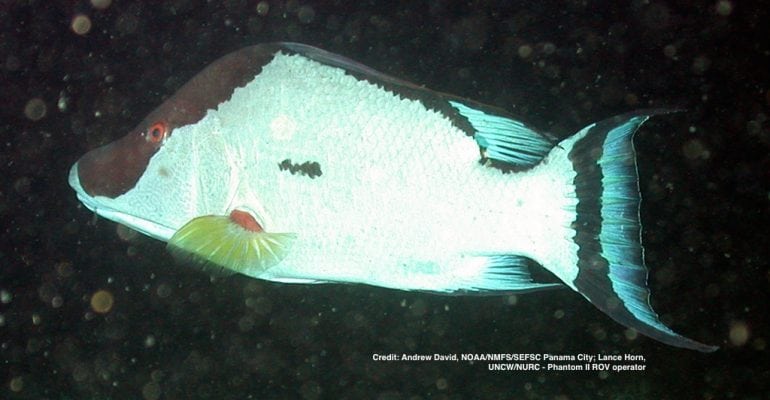NOAA Fisheries seeks public comment on an amendment and proposed rule that would establish management measures for the West Florida hogfish population in the Gulf of Mexico (Gulf). The Gulf of Mexico Fishery Management Council (Gulf Council) has submitted Amendment 43 to NOAA Fisheries for review, approval, and implementation. The Notice of Availability for public comment on this amendment published in the Federal Register on November 4, 2016.
Comment Period Ends January 3, 2017
Proposed Management Measures
- Revise the hogfish fishery management unit in the Gulf of Mexico federal waters to north of a line extending due west from 25°09′ North latitude off the west coast of Florida (West Florida Population);
- Establish hogfish status determination criteria for determining if the population is overfished (the population size is too low) or undergoing overfishing (too many fish are being caught);
- Set the West Florida population annual catch limit to 219,000 pounds whole weight for 2017 and 2018 and 159,300 pounds whole weight for 2019 and following years;
- Increase the West Florida population minimum size limit from 12 to 14 inches fork length to reduce the chances of exceeding the annual catch limit; and
- Remove the powerhead exception for harvest of hogfish in the Gulf stressed area so that the powerhead regulations are the same for all federally managed reef fish species.
The need for Amendment 43
The need for this action is to establish a population definition that is consistent with the best scientific information available, to prevent overfishing and to adjust annual catch limits consistent with a recent hogfish population assessment.
Background
A recent population assessment divided the hogfish population into three populations based on genetic analysis. The condition of these three populations is as follows:
- The West Florida population is not overfished or undergoing overfishing;
- The Florida Keys/East Florida population is overfished and experiencing overfishing; and
- The status of the Georgia-North Carolina population is unknown.
Because a small portion of the Florida Keys/East Florida population extends into the Gulf Council’s jurisdiction in south Florida, the Gulf Council is recommending the South Atlantic Fishery Management Council (South Atlantic Council) take the lead in setting the overfishing limit and acceptable biological catch for that population. The South Atlantic Council has also developed a rebuilding plan for the Florida Keys/East Florida population that requires specific management measures. For more information on the South Atlantic Council measures, see http://sero.nmfs.noaa.gov/sustainable_fisheries/s_atl/sg/2015/am37/index.html.
Please Note: This bulletin only summarizes the proposed actions and their effects. NOAA Fisheries encourages constituents to access Amendment 43 for more information at
http://sero.nmfs.noaa.gov/sustainable_fisheries/gulf_fisheries/reef_fish/2016/am43/index.html.
How to Submit Comments
NOAA Fisheries must receive comments on this notice no later than January 3, 2017. We will address all comments specifically directed to Amendment 43 and the proposed rule in the final rule. You may obtain electronic copies of Amendment 43 from the NOAA Fisheries Web site:
http://sero.nmfs.noaa.gov/sustainable_fisheries/gulf_fisheries/reef_fish/2016/am43/index.html or the e-Rulemaking Portal: www.regulations.gov.
You may submit comments on this document, identified by NOAA-NMFS-2016-0126, by any of the following methods:
Electronic Submission: Submit all electronic public comments via the Federal e-Rulemaking Portal. Go to
http://www.regulations.gov/#!docketDetail;D=NOAA-NMFS-2016-0126, click the “Comment Now!” icon, complete the required fields, and enter or attach your comments.
Mail: Submit written comments to Peter Hood, NOAA Fisheries, Southeast Regional Office, Sustainable Fisheries Division, 263 13th Avenue South, St. Petersburg, Florida 33701-5505.
Instructions: Comments sent by any other method, to any other address or individual, or received after the end of the comment period, may not be considered by NOAA Fisheries. All comments received are a part of the public record and will generally be posted for public viewing on www.regulations.gov without change. All personal identifying information (e.g., name, address, etc.), confidential business information, or otherwise sensitive information submitted voluntarily by the sender will be publicly accessible. NOAA Fisheries will accept anonymous comments (enter “N/A” in the required fields if you wish to remain anonymous).
NOAA Fisheries Southeast is pleased to announce the introduction of our Text Message Alert Program. The program will allow you to sign up to receive important fishery related alerts via text message. Text alerts you may receive include immediate fishery openings and closures, and any significant changes to fishing regulations that happen quickly.
How to opt-in
Sign up for related alerts for one or more of the following groups. Standard message & data rates may apply. You may opt-out at any time.
Gulf of Mexico Recreational Fisheries: Text GULFrecFISH to 888777
Gulf of Mexico Commercial Fisheries: Text GULFcommFISH to 888777
South Atlantic Recreational Fisheries: Text SATLrecFISH to 888777
South Atlantic Commercial Fisheries: Text SATLcommFISH to 888777
Caribbean Fisheries: Text CARIBFISH to 888777
About Gulf of Mexico Fishery Management Council
The Gulf of Mexico Fishery Management Council is one of eight regional Fishery Management Councils established by the Fishery Conservation and Management Act of 1976. The Council prepares fishery management plans, which are designed to manage fishery resources within the 200-mile limit of the Gulf of Mexico.





